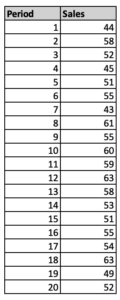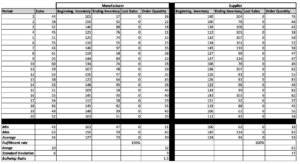The Bullwhip Effect is Back in the Limelight
When the pandemic made the demand for certain products skyrocket, we started hearing the term "bullwhip effect" a lot. But the bullwhip effect has existed in supply chains for decades. The fact is, the technology to address this has existed for a few years now. The issue is more rooted in trust among the players in a chain and the lack of will to invest in near real-time, seamless data sharing with each partner in the supply chain. Many may argue that it is more a result of a lack of technology. Still, the fact is, for many supply chains where every player involved in the value chain is a major corporation, technology exists today to help address the bullwhip effect, provided these players are willing to invest money and trust. Technologies like EDI have existed for decades to allow sharing the level of data that can help mitigate the bullwhip effect. Collaborative planning processes like CPFR have also existed for years. The focus of this article, however, is more on measuring the impact of bullwhip and the impact of bringing visibility into the supply chain. We will cover how we can quantify the magnitude of the bullwhip effect in our supply chains.
Validating the Effect
We will use an extremely simple supply chain structure to illustrate the measurement method for the bullwhip effect. The supply chain is a retailer fulfilled by a manufacturer with only one raw materials supplier. Now let us lay down some demand planning and ordering rules for our simple supply chain. We will use very simple rules here. A critical aspect that you need to keep in mind is that as the complexity of these rules in silos increases, the magnitude of the bullwhip effect will increase.
- The demand is relatively stable.
- Ad-hoc forecast updating and ordering policy at each level in the chain
- At the end of a period t, place an order for 2Dt-Inv_t. Dt is the actual demand in period t and Inv_t is the ending inventory in period t, computed after filling as much of Dt from inventory as possible
- Current demand is used as the forecast of future demand
- Replenishment lead time is one period (an order placed at the end of one period arrives at the beginning of the next period) or zero
- Safety stock is one period's worth of inventory
Now let us assume that the consumer sales data at retail locations for 20 periods is as shown below:

Now let us try to simulate the orders this demand table will generate across our simple supply chain. Based on the rules defined above, the following is the order quantity for the manufacturer and its supplier for the 20 periods is indicated above. Note that the demand table is NOT being shared across the supply chain. Only the manufacturer has visibility into the retail demand table. And similarly, the supplier has visibility into only the orders placed by the manufacturer.

Now, let us calculate some fundamental statistics for consumer demand and manufacturer and supplier orders, as shown below:

As you can see in the graph above, this example demonstrates an apparent bullwhip effect, with manufacturing orders demonstrating more volatility (standard deviation) than customer sales and supplier orders demonstrating much more variability than manufacturers. Note that because of the inherent simplicity of assumptions and made-up numbers, the difference is significantly less than the real world but illustrates the concept. So we know that Bullwhip exists, but duh…we already knew that. So let us move to the critical question.
How Do we Measure the Magnitude?
Now there can be various ways, and a best practice I suggest is to create some unique metrics based on your unique supply chain parameters and nuances to measure “true” bullwhip but to keep it simple and general, one straightforward way is :
Taking the ratio of the standard deviation of orders placed at each stage to the satndard deviation of consumer sales reported.
Let us name this ratio "bullwhip ratio." So, let us revisit our previous example and measure the magnitude of the bullwhip effect. We calculate the bullwhip ratios as Manufacturer: 1.5 and Supplier as 2.8. In the example and the subsequent measurement of Bullwhip, we can see that even without including various “real world” supply chain complexities in the demand stream, you can see a substantial Bullwhip effect.
Even the simplest of complexities make it worse.
Now, this is an experiment that I leave up to interested readers to calculate, but if you introduce complexity as simple as changing the replenishment lead time to two periods from one, the ratios that you see above change to the following:
- Manufacturer’s bullwhip ratio: 3.85
- Supplier’s bullwhip ratio:5.44
That simple change nearly doubled the bullwhip ratios. And we know the complexities that exist in our supply chain planning processes today.
 Now let us try to simulate the orders this demand table will generate across our simple supply chain. Based on the rules defined above, the following is the order quantity for the manufacturer and its supplier for the 20 periods is indicated above. Note that the demand table is NOT being shared across the supply chain. Only the manufacturer has visibility into the retail demand table. And similarly, the supplier has visibility into only the orders placed by the manufacturer.
Now let us try to simulate the orders this demand table will generate across our simple supply chain. Based on the rules defined above, the following is the order quantity for the manufacturer and its supplier for the 20 periods is indicated above. Note that the demand table is NOT being shared across the supply chain. Only the manufacturer has visibility into the retail demand table. And similarly, the supplier has visibility into only the orders placed by the manufacturer.
 Now, let us calculate some fundamental statistics for consumer demand and manufacturer and supplier orders, as shown below:
Now, let us calculate some fundamental statistics for consumer demand and manufacturer and supplier orders, as shown below:
 As you can see in the graph above, this example demonstrates an apparent bullwhip effect, with manufacturing orders demonstrating more volatility (standard deviation) than customer sales and supplier orders demonstrating much more variability than manufacturers. Note that because of the inherent simplicity of assumptions and made-up numbers, the difference is significantly less than the real world but illustrates the concept. So we know that Bullwhip exists, but duh…we already knew that. So let us move to the critical question.
As you can see in the graph above, this example demonstrates an apparent bullwhip effect, with manufacturing orders demonstrating more volatility (standard deviation) than customer sales and supplier orders demonstrating much more variability than manufacturers. Note that because of the inherent simplicity of assumptions and made-up numbers, the difference is significantly less than the real world but illustrates the concept. So we know that Bullwhip exists, but duh…we already knew that. So let us move to the critical question.








